
College-bound students, and their parents, are making smart decisions when choosing undergraduate colleges. Even when students get into their first-choice colleges, students are carefully reviewing scholarship and financial aid offers and opting not to jump into huge debt at the more prestigious institutions.
Students are more cognizant of the long-term financial effect of student debt on purchasing their first homes, starting families, and building personal portfolios. It used to be that students would insist on going to the most selective college and parents would dip into their home’s equity or retirement savings to grant their children’s and their own bragging rights. Not anymore.
Over the past few years (even pre-COVID-19), students have been opting for in-state public universities when financial aid offers at the ivies and other selective colleges didn’t substantially reduce the tuition cost. This is especially true for students who intend to pursue higher degrees.
I believe students can get an excellent education and great prospects for higher ed and great careers without paying exorbitant fees ($300,000+). By organizing a comprehensive 4-year plan, students can take interesting classes (and their prerequisites) while satisfying major and general ed requirements, and still do research, internships, and clubs.
In addition to gaining the experience and knowledge through their undergraduate programs, students can also do projects to demonstrate their acumen and potential to future admissions committees and employers. It’s not so much about the college as it is about the student.
Glad to see students making well-thought out decisions based on what they need and want, and not on the US News and World rankings.

College-bound students, and their parents, are making smart decisions when choosing undergraduate colleges. Even when students get into their first-choice colleges, students are carefully reviewing scholarship and financial aid offers and opting not to jump into huge debt at the more prestigious institutions.
Students are more cognizant of the long-term financial effect of student debt on purchasing their first homes, starting families, and building personal portfolios. It used to be that students would insist on going to the most selective college and parents would dip into their home’s equity or retirement savings to grant their children’s and their own bragging rights. Not anymore.
Over the past few years (even pre-COVID-19), students have been opting for in-state public universities when financial aid offers at the ivies and other selective colleges didn’t substantially reduce the tuition cost. This is especially true for students who intend to pursue higher degrees.
I believe students can get an excellent education and great prospects for higher ed and great careers without paying exorbitant fees ($300,000+). By organizing a comprehensive 4-year plan, students can take interesting classes (and their prerequisites) while satisfying major and general ed requirements, and still do research, internships, and clubs.
In addition to gaining the experience and knowledge through their undergraduate programs, students can also do projects to demonstrate their acumen and potential to future admissions committees and employers. It’s not so much about the college as it is about the student.
Glad to see students making well-thought out decisions based on what they need and want, and not on the US News and World rankings.

While I am just one person, if others make a conscious effort to change little things, we can do BIG THINGS to stave off the destructive path we face as the Earth heats up. It’s all about the numbers. When one person does something: no change. When millions of individual people do something: we save our lifestyles – and our lives.
Here are 10 things that I pledge to do starting today:
#1: Reduce my driving by 50%
I will plan my outings and do them all on one day per week.
#2: Eliminate buying single-use plastic bottles, straws, and take-out containers.
I will buy beverages sold in glass bottles only, or use my reusable glass bottles. I’ll use my reusable metal straws. I’ll use my glass containers for doggie bags and insist that restaurants use my containers for take-out orders.
#3: Reduce the number of truck deliveries to my house each week.
I will select Friday deliveries from Amazon to reduce both packaging and fuel emissions.
#4: Stop using clean, drinking water to flush my toilet.
I will use water captured from my showers and baths to flush my toilet in my home.
#5: Use 50% less drinking water to irrigate my fruit orchard and 6 gardens.
I will use water captured from my rooftop and stored in a 5000-gal tank and 18 IBC tanks (275 gal each).
#6: Discourage people and corporations from clear cutting forests to provide grazing for cattle.
I will not eat meat or dairy products 6 days per week.
#7: Ban purchases of non-organic food to stop Monsanto from poisoning us with Roundup and GMOs.
I will grow my veggies and fruit using aquaponics, hydroponics, greenhouse, and permaculture systems. For veggies and fruit I can’t grow, I’ll get them at our local farmer’s market or from Imperfect Foods.
#8: Petition and fight oil and gas companies from fracking and drilling for methane (natural gas) and petroleum (gasoline).
I plan to install more solar panels (we have 64 now) and purchase only electric or hydrogen fuel cell cars in the future (have one Tesla now, and have my eyes on the Toyota Murai hydrogen fuel cell car).
#9. Use LED light bulbs for 100% of my lighting.
I will only purchase LED bulbs and replace all existing incandescent and fluorescent bulbs.
#10. Educate and encourage teens to proactively change their lifestyles to promote a future where it’s safe to raise families.
I will guide students as they do projects that highlight problems covered up by corporations and give the teens a platform to reach large audiences through TEDxMeritAcademy.

If you, or your child, got “rejected” from the college you were hoping for, you’re not alone. This has been a really competitive year for everyone. Now that most of the Ivies and other selective colleges have announced admissions decisions, many students are reeling from the pains of being overlooked or waitlisted.
Colleges have seen an uptick in applications from minority and first-generation students. Other colleges have given coveted spaces to gap-year students who differed from last year. And of course, those legacy students got in because mommy or daddy donated big bucks (that’s still legal). This trickle-down yield affects all colleges. Admit rates have decreased this year (meaning they’ve become more selective). Emory fell from 19% to 13%, Swarthmore 9% to 8%, and Colby 13% to 10%.
Remember that there are over 4,000 colleges and universities in the United States. Most are desperately seeking students to fill their 2021-2022 classes. There are many excellent colleges that are still accepting applications – so if you aren’t happy with your college options, you can still apply to other colleges.
I believe that students make their own college experiences. By creating a comprehensive 4-year plan at their future college (before starting), you can work with professors doing exciting research, carve out your personal academic program, do research and internships, and meet new people in clubs and programs that your college offers. Forget about name-brand colleges and the rankings – there’s a lot of hype and hysteria that many students and families fall prey to.
You can make plans that will give you an excellent education, prepare you for grad school or your dream career, and ultimately keep you happy and sane.

This has been quite an unpredictable college admissions year for our college-bound students. At first, we thought that colleges going test-blind or test-optional (SAT/ACT) was going to make it easier for students to apply – and therefore, increase their chances of getting into more selective colleges. But, the ivies and the most selective colleges (both public and private) have received upwards of 20% more applications this year compared to previous years.
All colleges are worried that they may not make their “yield” in students accepting their admissions offers, paying the deposit, and actually starting this fall. The pandemic and the economy have changed the formulas colleges normally use to determine their expected yield. To ensure that they will have a full class of students starting this fall, college admissions departments are placing large numbers of students on their waiting lists.
What does this mean?
When a college offers acceptance letters to 3000 students, they may expect 1800 to actually attend. Depending on the number of students who pay their deposits on May 1st, that college will probably accept students off their waiting list. Colleges generally accept between zero to 200 students off their waiting lists (this varies greatly between colleges).
This year (and in recent years), many colleges are placing close to the same number of accepted students on their waiting lists. So if a college accepts 3000 students, they may also place another 3000 students on their waiting list – even though they will most likely actually make offers to only about 200 students after May 1st.
Colleges need to ensure their yields, and they also want to soften the blow for legacy students. When colleges can’t accept alumni’s children, offering a position on the waiting list may feel less like a rejection. This is also true for other students; nobody likes to receive a denial letter – you know, the small envelope.
The problem with super selective colleges offering more waiting list spots is that it negatively affects all students. If top students are on waiting lists from their first choice colleges – say, ABC College, and subsequently accept to a lower-tiered college – say, DEF College, these top students are taking the place of students who really want to go to DEF College. The same happens with those on waiting lists to get into DEF College, when they accept to GHI College.
So what do you do if you’re on the waiting list?
Immediately write a letter stating your intent to enroll should you be given the opportunity to attend this fall. Colleges don’t rank their waiting lists and only consider students who respond to their waitlist offers. Tell them why you’re a good fit and what you can bring to their campus. Don’t call or send them things that they already know about. If you have made progress on your project, give them an update to remind them that you’re brilliant and motivated. Show them why you should be admitted.
You’re not alone as you consider your options. Good luck!

Just built 2 new chicken coops for our 5 hens. Our old coops were falling apart and this gave us the opportunity to rethink their living quarters. After combing through pages of chicken coop kits, we finally settled on one that has a slide-out tray for easy cleaning (something we didn’t think about when we built our first coops. These kits are made of cheap materials and they’re designed to fall apart quickly. So I added twice as many screws and sealed them to protect the raw wood – hoping they’ll last for 5 years.
I put the water bucket on a plant stand so the chickens could get the water from a nipple under the bucket, while making it impossible for rodents to reach it. We bought a chicken feeder that requires the chickens to stand on a plate to open it – making it impossible for critters to have access to the food. This has saved us hundreds of dollars in feed.
Then I created a chicken foraging area where they can scratch and peck the ground to find bugs or other things to eat. This usually creates a big mess so I used cinder blocks to help contain the sawdust and hay. I give them buckets of weeds and mealworm treats when I collect their 5 eggs every day. I also made a roosting area outside the coop so the hens could hang out and enjoy the views.
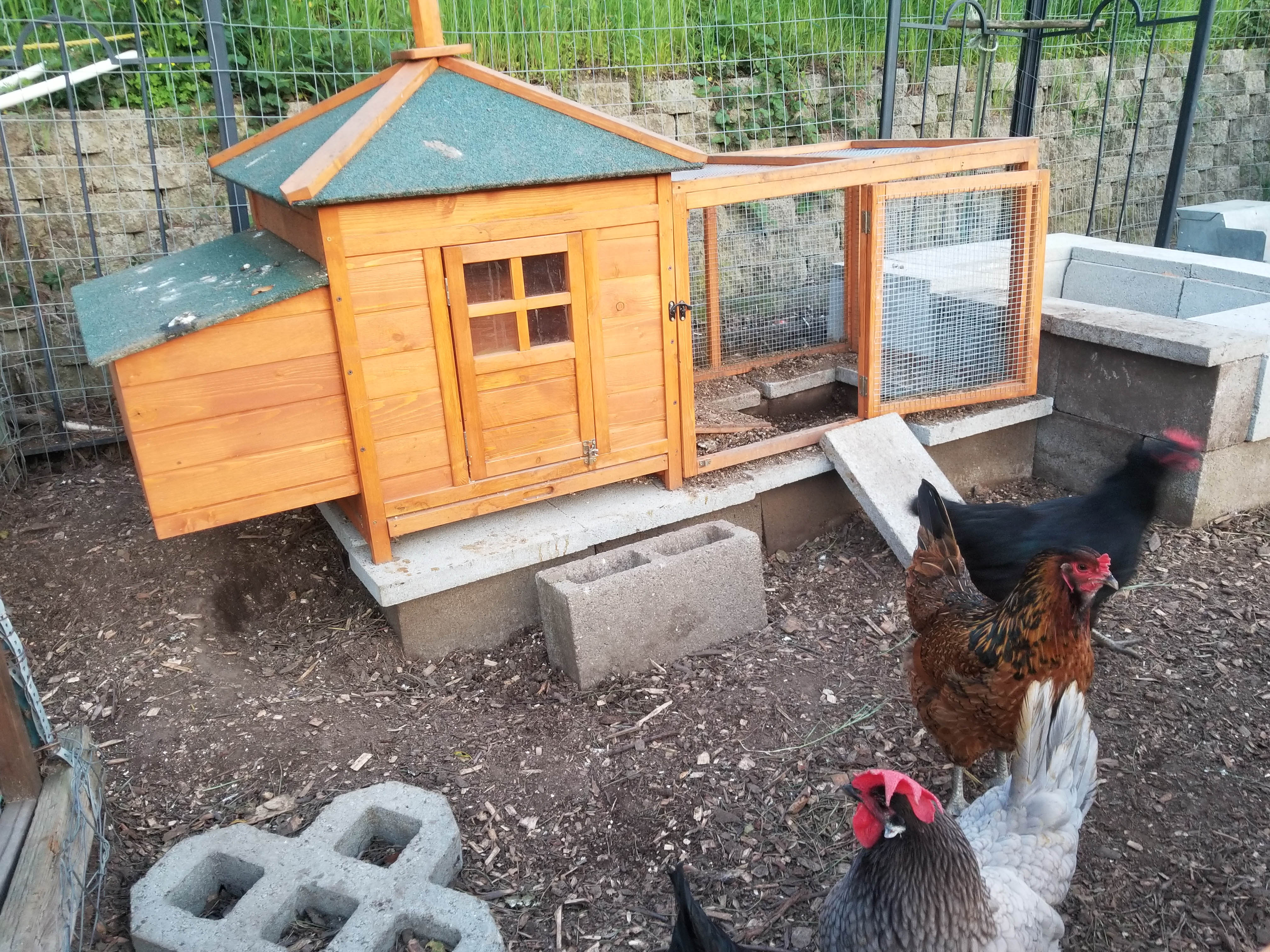
New chicken coop
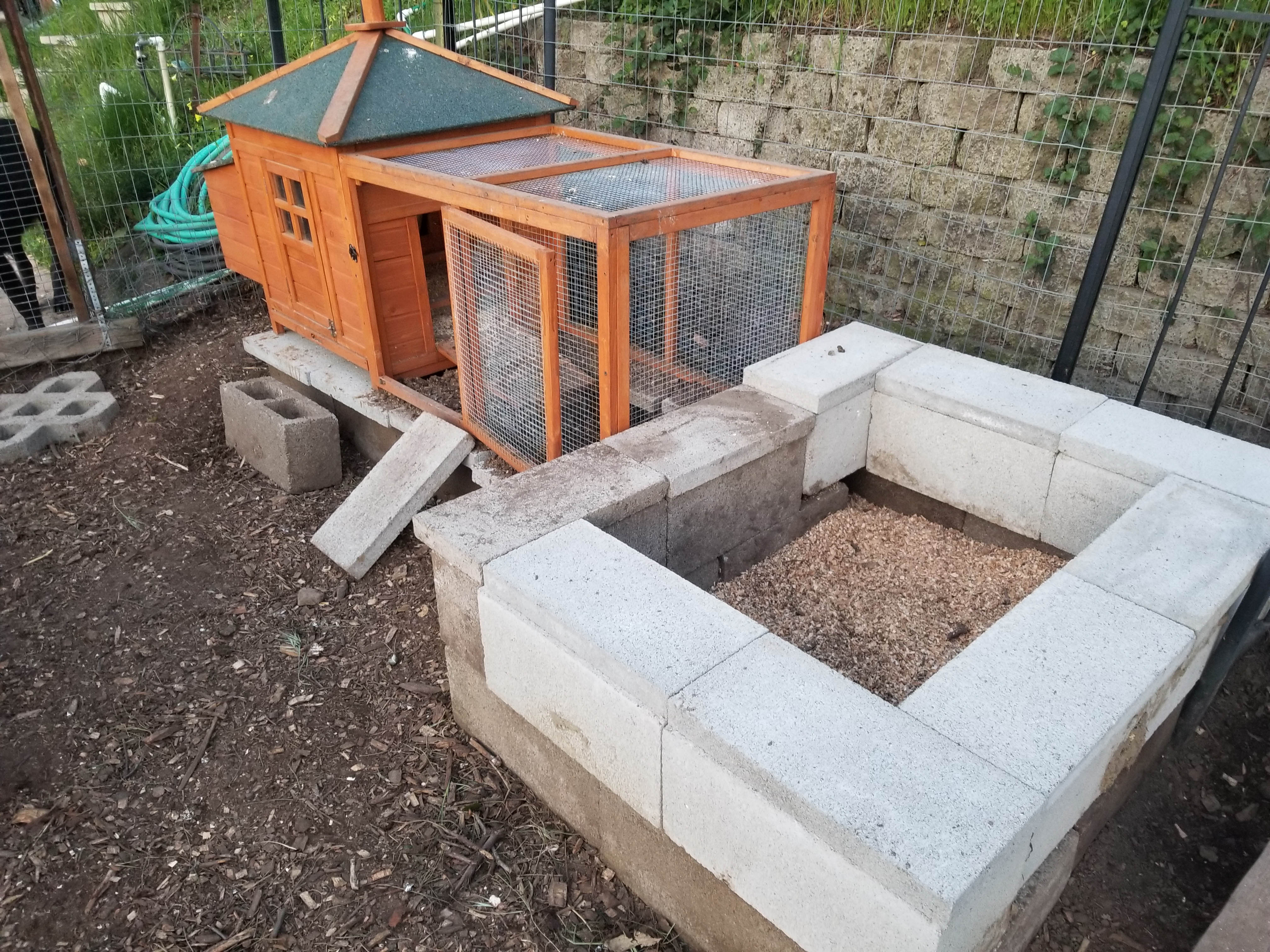
Chicken scratch area
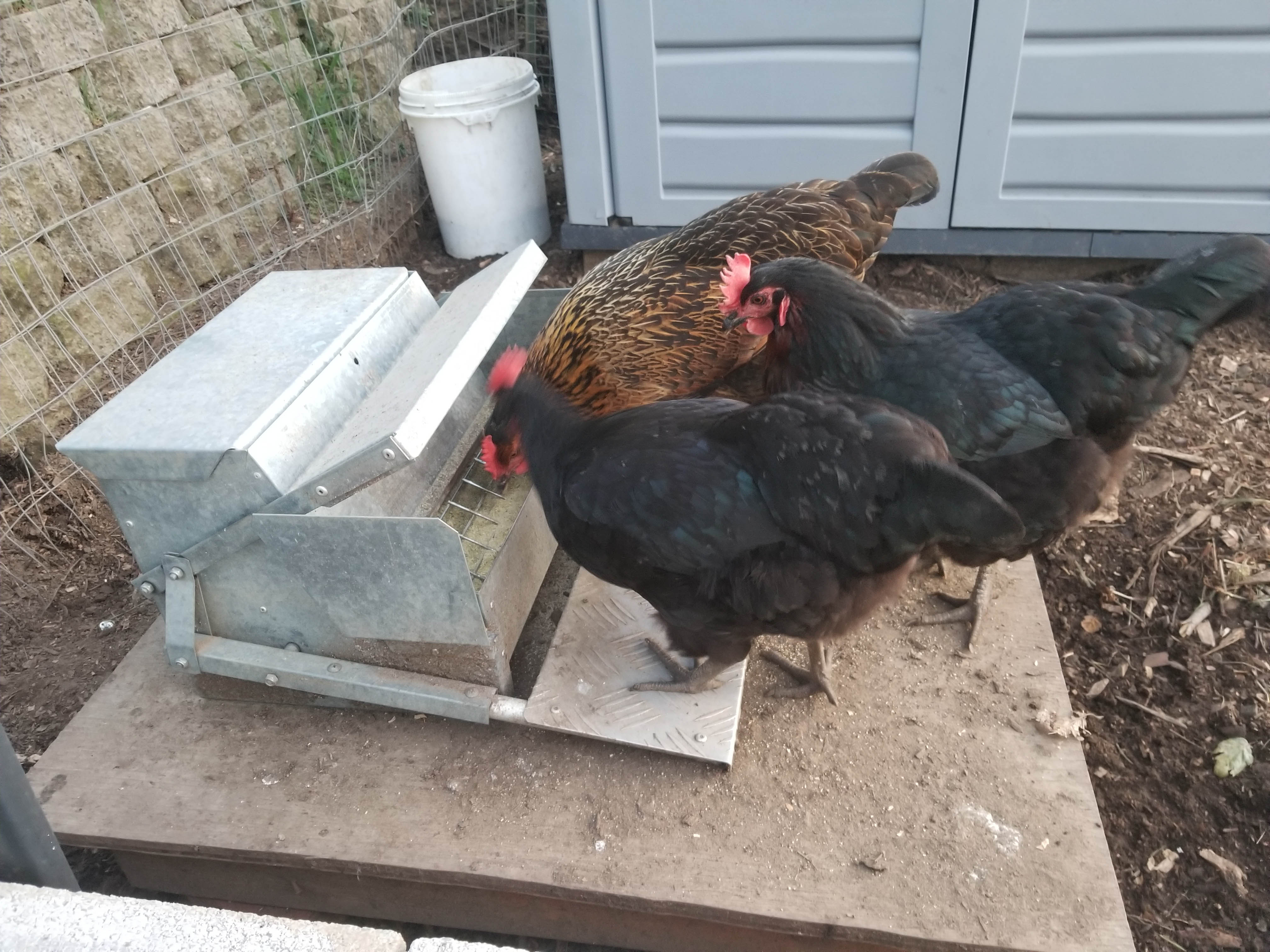
Feeder that opens when the chickens stand on the lever; keeps rodents out and saves lots of money!
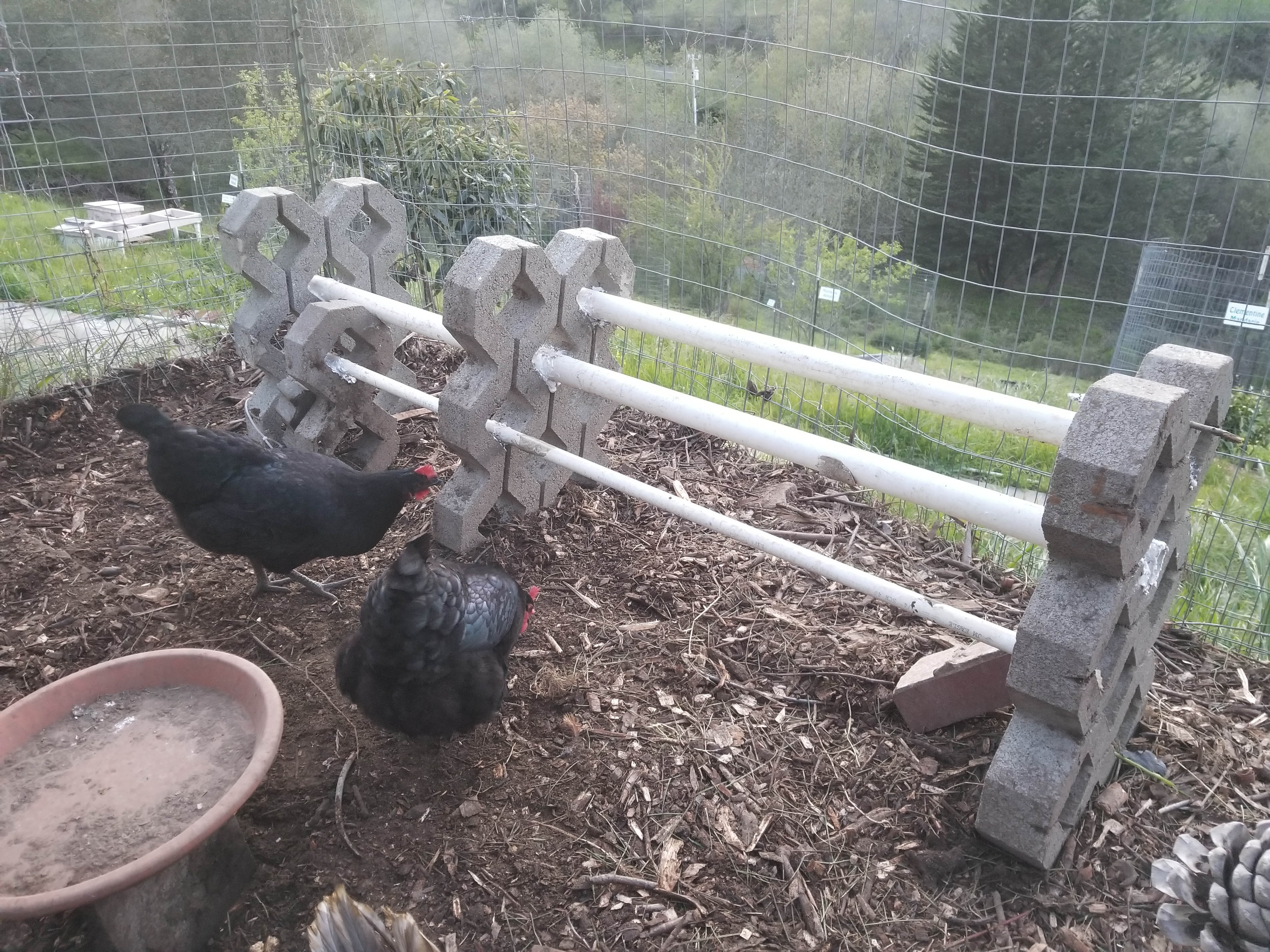
Chicken roosting area — with a view!
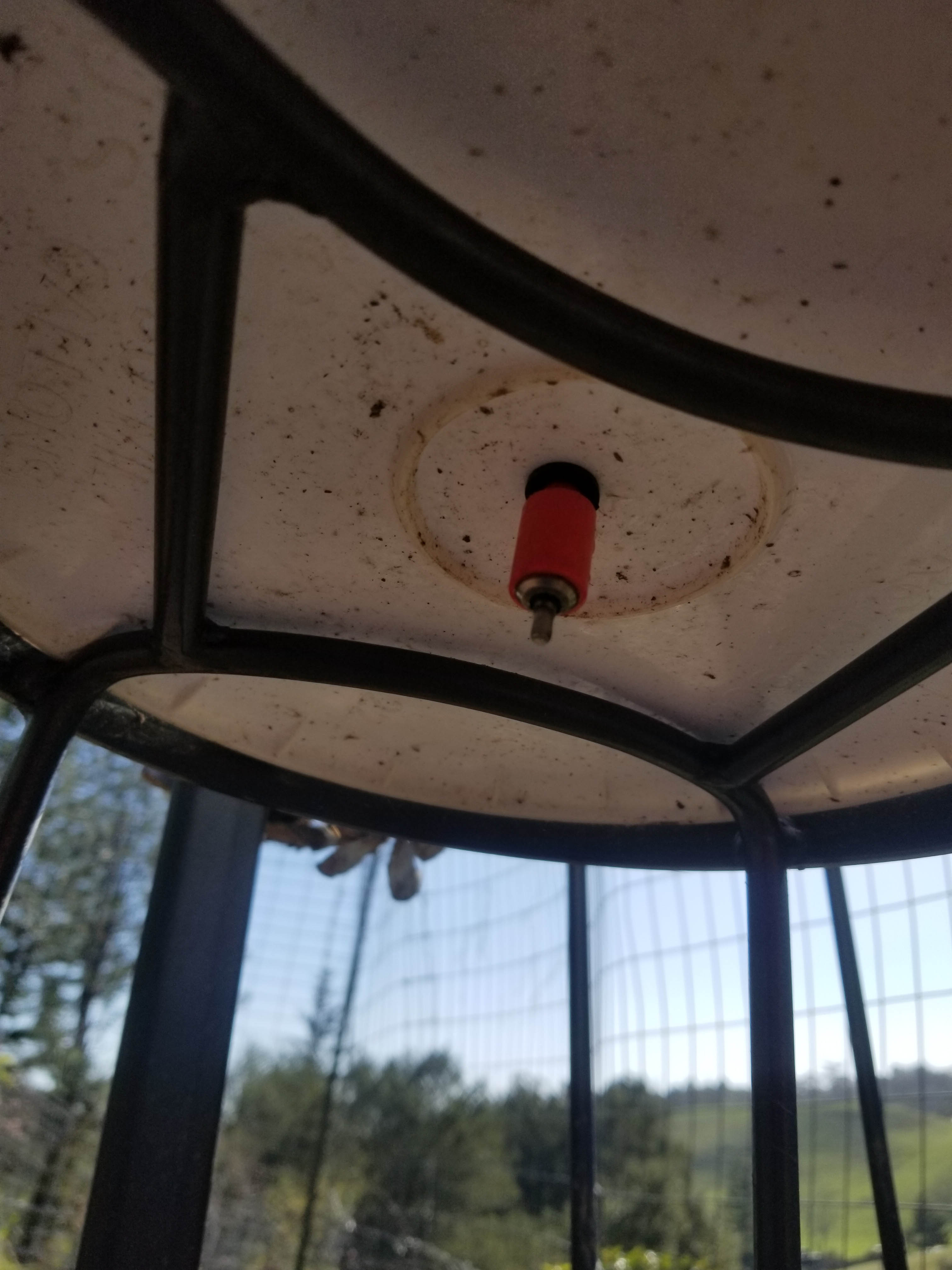
Nipple below 5-gallon water container. Chickens get fresh water while rodents can’t reach it!

Chickens pecking at water nipple
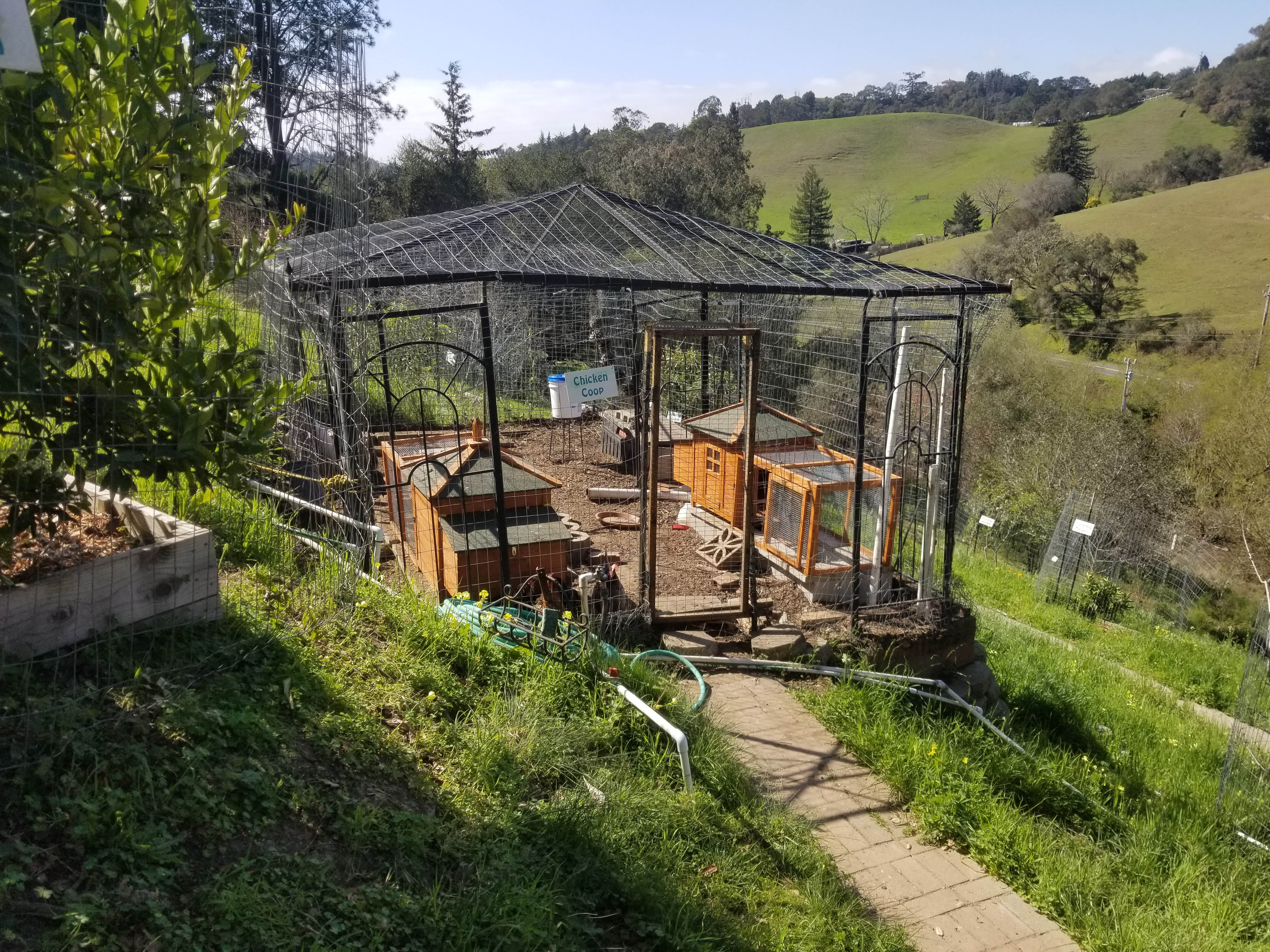
20′ by 12′ chicken coop that is surrounded by heavy-duty fencing on 6 sides to keep out raccoons and other predators.

Over 100,000 people have viewed “Racism and America’s Concentration Camps” a TEDxMeritAcademy talk. Mas Hashimoto was a featured speaker, and his TEDx Talk is embedded below. Check it out.
Remember when the American government unjustly incarcerated 120,000 persons of Japanese ancestry, most of whom were American citizens, during WWII? Mas Hashimoto compares how Japanese American incarceration during WWII and the massive discrimination of Muslims post 9-11 are both founded in hate and racism. Learn how “Make America Great Again” really translates to “Make America White Again.” Learn about what you can do to stop this form of racism and take active steps to protect everyone’s civil and human rights.
About Mas: Mas Hashimoto was a child when his family was taken from their Watsonville home in 1942. He was sent to a federal prisoner of war camp during WWII because of racism, war hysteria, and political leadership failure. Mas taught US History in the Pajaro Valley Unified School District until his retirement. He speaks to groups of students about the wartime experience of Japanese Americans during WWII to ensure that this injustice never repeats itself again. Mas also headed the Re-enactment of the Incarceration of Japanese Americans during WWII: “Liberty Lost; Lessons in Loyalty” in 2002, and serves on the Board of Directors of the Watsonville-Santa Cruz chapter Japanese American Citizens League.

Imagine for a moment – that your government issues an executive order stating that all citizens of your ethnicity has 3 DAYS to pack what you can in ONE SUITCASE and sell your possessions (home, cars, businesses, clothes, heirlooms, photos). You have no idea where they’re going to take you or how long you’re going to be there. This happened in 1942 to 120,000 Japanese Americans who were US citizens.
As a 3rd generation Japanese American, I still have difficulty wrapping my head around this gross injustice that happened simply because of our ancestors’ affiliation with Japan. Not one Japanese American was found to be a “spy” – the reason the US government incarcerated JAs along the west coast for over 3 years.
I talked with my grandparents about their experiences in these internment “relocation” camps. They never wanted to speak out against America because they loved being in America. But my uncle told me stories about the vitriol and hatred people had for anyone who looked Asian. While standing on a corner at 5 years old, holding his father’s hand, people called them “Japs!” and spat at them.
My family lost their business, vehicles, and trust. After WWII, they had to rebuild their lives while being subjected to hate crimes they never reported. Because we look different from Caucasian Americans, we became the easy target of misplaced anger. This was clearly discrimination by the government and the public.
While Germany and Italy were also clearly the enemies during WWII, German Americans and Italian Americans were not incarcerated like the Japanese Americans. JAs from Washington, Oregon, California, and Arizona were forced to relocate to 10 relocation camps. If the government was concerned about spies on the west coast, then why did they NOT incarcerate JAs in Hawaii?
I write this to help us see one piece of discrimination and hate against Japanese Americans. It’s happening against Chinese Americans (and Asians) today because of the fear and unknowns about the coronavirus. Unhappy and insecure people often seek what they consider “underdogs” to pick on just the way bullies do on the school yard, social media, and the workplace.
Don’t be complicit. Stand up and speak out against hate crimes.

The May 1st deadline for all high school seniors to choose the colleges they plan to attend in the fall may not be the end of the admissions cycle this year. Normally, students apply to colleges as early as October of their senior year (for Early Decision and Early Action), by November/December for large public universities, and by January for Regular Decision for most private colleges and universities. Most students receive admissions decisions between December and March – giving them the month of April to compare financial aid offers and to visit campuses.
Amidst the pandemic, many colleges are struggling to get admissions decisions and financial aid offers to students and some have announced that students may not hear from them until the end of March or the beginning of April. With most colleges conducting remote learning, students are having to do virtual tours and participate in online activities that would typically take place on campus. This is all unsettling for students and their parents.
But now that the Biden Administration has announced that there will be enough vaccines for all Americans by May 1st, everyone is hopeful that students can start visiting college campuses and make decisions about where to go to college the good old fashioned way.
Many colleges have extended the May 1st deadline to June 1st or 15th. While this may sound altruistic, colleges are extending deadlines so they can ensure that they get their yield for the 2021-2022 academic year. Colleges are also wait listing many more students this year, for the same reasons. The good old fashioned way.
Many colleges have extended the May 1st deadline to June 1st or 15th. While this may sound altruistic, colleges are extending deadlines so they can ensure that they get their yield for the 2021-2022 academic year. Colleges are also wait listing many more students this year, for the same reasons. The good news is that students may be able to take their time to decide where they plan to go to college this fall.
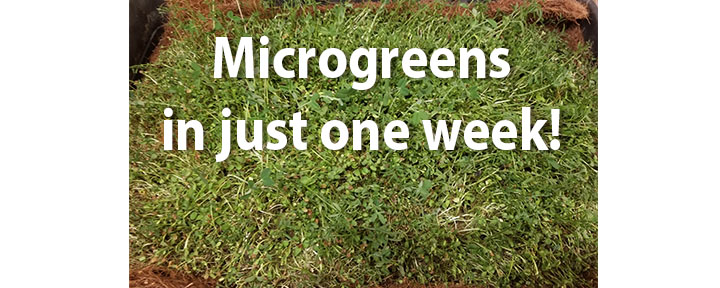
I just harvested my first crop of microgreens – successfully — last week. While it is supposed to be really easy to grow, I tried to grow them 3 years ago but it was a complete failure. I bought the trays, poured potting soil, and sprinkled microgreen seeds on top and left them in the greenhouse. The growth was spotty, and when I went to harvest them, they were tangled in clumps of soil that made them inedible.
Wanting to have microgreens for my salads and sandwiches because of their incredible nutrients, I did some research and started growing them again. This time, I used coconut coir, or coconut husk, instead of soil. I also poured lots of seeds on the coir and I watered them every day. It’s amazing what happens when you pay attention to your garden! In just a few days, I saw sprouts that grew into a lush thick blanket of microgreens.
My new plan is to grow less but start new batches every 2-3 weeks so I could have a steady flow of microgreens. To help me remember to water them, I placed them next to the fish in my aquaponics system so I feed the fish and water the microgreens at the same time.

UCs will start notifying freshman applicants of admissions decisions in the next few weeks, and transfer applicants by end of April. Normally, April is the month to visit college campuses to make final decisions colleges, but the UCs will not have on-campus Admit Days this year. Instead, they’ll all have virtual activities and seminars that include financial aid/scholarships, choosing majors, housing, support services, and student organizations.
Here are the dates for each UC campus:
UC Berkeley: April 3, Cal Week: April 24 —30
UC Davis: March 30 — April 3
UC Irvine: March 26 — April 17
UCLA: April 5 —16
UC Merced: March 9 — April 24
UC Riverside: April 5 — 7
UC San Diego: April 10, with other events continuing throughout April
UC Santa Barbara: March 22 — 25 and April 26 — 30
UC Santa Cruz: March 20 — April 10
To accept to one UC, pay your Statement of Intent to Register (SIR) and pay the $250 deposit by May 1st. The SIR is nonrefundable and non-transferable, but the payment does go towards your first enrollment term tuition.
Students will need to satisfy the Entry Level Writing Requirement (ELWR) by taking the Analytical Writing Placement Exam (AWPE) on Saturday, May 22nd or by satisfying the requirement with qualifying SAT, ACT, AP or IB scores or receiving a C or higher in a college English composition course. Check with your college before signing up for the AWPE because UC Davis, UC Irvine, UC Santa Barbara, and UC Santa Cruz are not requiring the AWPE but have other rules.
